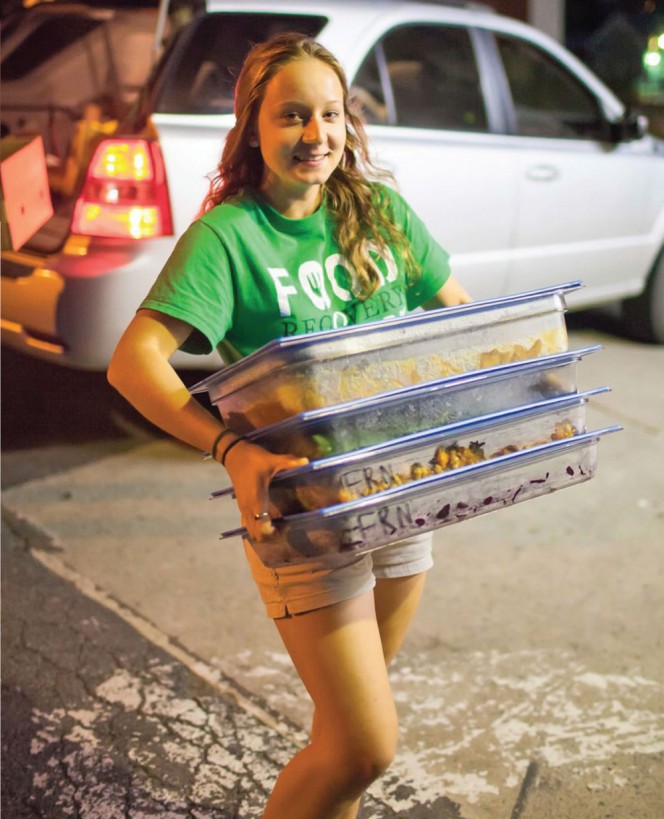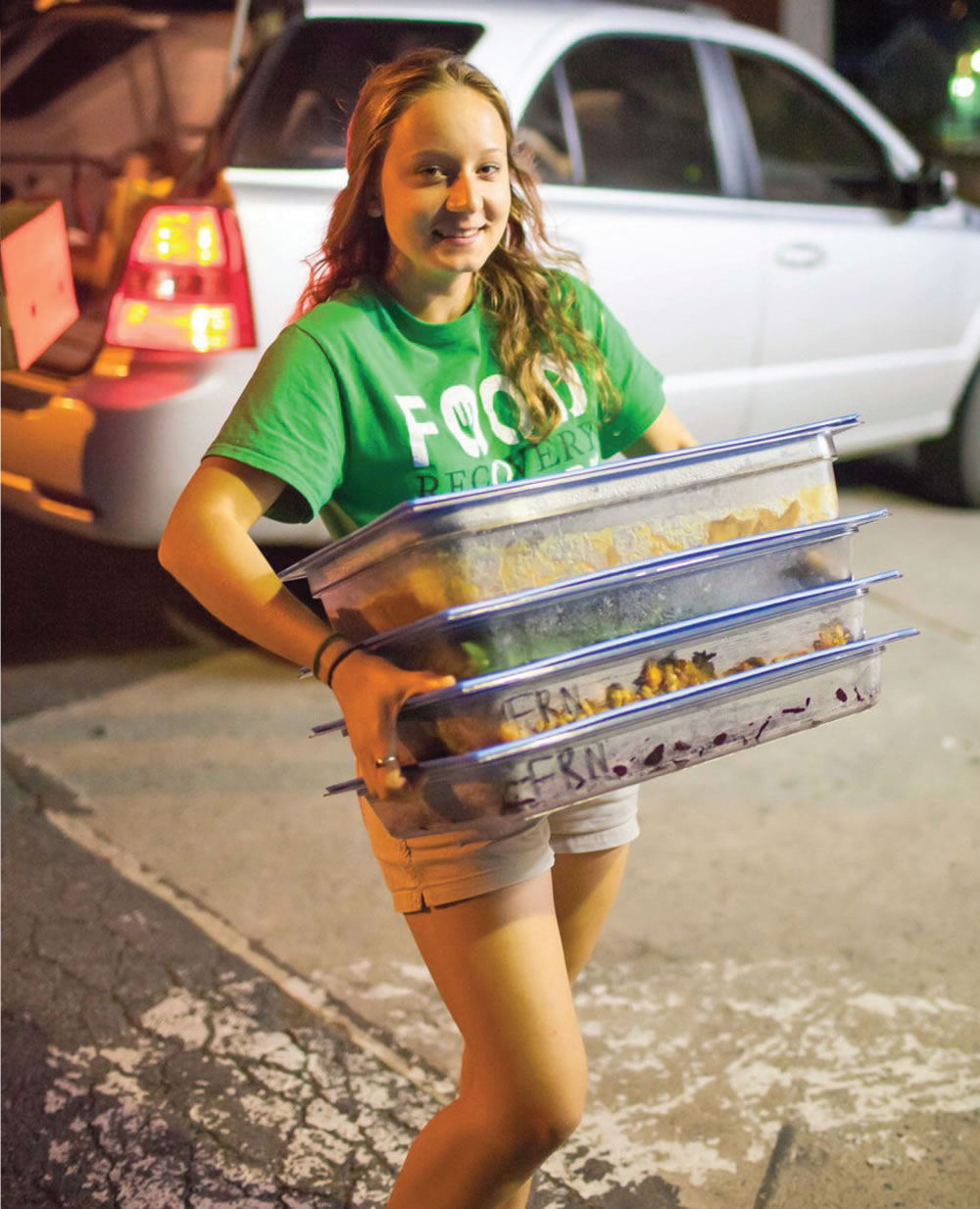The Food Recovery Network has 171 chapters on college campuses in 40 states that, in total, have donated 1.1 million pounds of food.
Marsha W. Johnston
BioCycle March/April 2016
The Food Recovery Network (FRN) still gets phone calls from people mistaking it for the Food Network, but if the pace of its growth over the last five years continues, FRN brand recognition may one day rival that of the culinary TV channel. “They are on fire,” notes Shondra Jenkins, director of community relations for Sodexo and executive director of the Sodexo Stop Hunger Foundation.

Food recovered through the FRN chapters includes surplus prepared food, fresh produce and baked goods. All chapters are trained in food safety. Photo courtesy of the Food Recovery Network
FRN launched in September 2011, when Ben Simon, Mia Zavalij, Pascual and four other students at the University of Maryland (UMD), College Park noticed still edible dining hall food ending up in the trash. Operating out of the main university library, FRN at UMD had recovered 30,000 meals for DC-area partner agencies by the end of the school year.
In Spring 2012, a second FRN chapter was founded at Brown University, and the two schools joined forces with two other campus food recovery programs — the University of California at Berkeley and Pomona College. By June, Simon, who had become Executive Director, was recognized as a regional honoree and received a $1,000 grant from Sodexo’s Stephen J. Brady STOP Hunger Scholarship. Simon maintained his relationship with the foundation, which eventually culminated in the $150,000 Sodexo Foundation grant.
Today, FRN operates with a $500,000 annual budget. The majority of its funding comes from dining services companies and their foundations, including the Sodexo Stop Hunger Foundation, Chartwells Higher Education, and General Mills. Its work sustains an estimated 250 organizations, thanks to the thousands of volunteers every semester.
The food FRN recovers, explains Pascual, runs the gamut from surplus prepared food like chicken parmesan to fresh produce and baked goods (see box). All FRN chapters are trained in food safety and supplied with funding to purchase food safety supplies like gloves, hairnets and thermometers to monitor the food being donated. “Through Sodexo’s expertise, we have been able to coach [FRN] with food safety and food handling procedures,” notes Jenkins. “Our employees are contributing skills and time to develop the organization.”
She adds that funding FRN since 2013 has enabled it to positively impact one of the foundation’s primary objectives: engaging youth to fight hunger. “Although it is young, FRN, as an organization, is doing amazing things with the funds we’ve invested, developing youth leaders and engaging the community. They are getting this generation actively involved in ending hunger in their generation.” There are 50 FRN chapters on campuses where Sodexo operates dining services.
Corps Of Volunteers
Volunteers are at the heart of FRN. Its 2014-2015 annual report states: “Our students are putting higher education on track to be the first sector of the economy without food waste. They’re pioneering. They’re self-publishing books on the homeless in their local communities. They’re transporting recovered food in bike carts. They’re organizing sleep-outs and food justice panels and skill-sharing sessions to learn how to use food scraps in recipes. They’re working with app developers and starting their own food recovery nonprofits to fight food waste off campus. These students are an emerging generation of leaders fighting food waste, fighting hunger, and changing the way we think about food…letting the country know that enough is enough: wasting 40 percent of the food we produce while one in six Americans don’t know where their next meal is coming from just won’t stand. Together we can continue making food recovery the norm, not the exception. Let’s fight waste and feed people!”
On the day of BioCycle’s visit, the FRN office near the UMD campus was buzzing with at least a dozen staff and volunteers on the phones. (FRN now has 14 full-time staff of predominantly recent grads, including 8 fellows). On one wall, a couple dozen colored post-it notes covered a large grid laying out FRN’s multistep approval process. Each note denotes a new applicant.
Applicants must meet the following requirements to start a new chapter:
1. Be a current student or faculty member at a college or university in the United States or a U.S. territory that is not listed on the “Chapters” page of the FRN website.
2. Be “serious” about starting a recovery program at their school and commit to being responsive to email and phone.
3. Have between 2 and 4 hours per week for a given semester to dedicate to starting a program and sustaining it.
The applicants have a wide range of preparedness. “It ranges from ‘I just saw this and want to apply but I know nothing about food waste’ to ‘I’ve already talked to our dining services manager and we have $1 million in our program budget!’,” explains Pascual. After submitting an online application to establish an FRN chapter, the applicant must complete a bimonthly phone training with a FRN office staffer that teaches them how to: build a leadership team; find a partner NGO (nongovernmental organization) agency for the donations; engage with the university’s dining service; transport food safely; and secure materials for recoveries. “It’s totally student-driven; they are in complete control,” she adds. “As long as the group they want to donate to is an NGO that can follow all of the food safety regulations and has the equipment, they get to pick.”
Depending on the school, the leadership teams are comprised differently, but are often drawn from sustainability clubs or service organizations, notes cofounder Mia Zavalij.
The phone training allows FRN to provide new members with best practices and answers gleaned from its ongoing relationships with the country’s major dining hall service companies, including Sodexo, Aramark, Chartwells Higher Education, and Bon Appetit Management Company. “The information is all based on their experience working with FRN at the schools they serve,” says Pascual.
After selecting their NGO partners, the new applicants finalize a member agreement with FRN and a partnership agreement with the nonprofit to receive the food. Some university dining service organizations ask the FRN chapter to comply with their company’s policies, e.g., wearing nonslip covers on their shoes during recoveries, but typically there is no official signed agreement, explains Sara Gassman, FRN director of member support and communication. “We are trying to keep this as nonbureaucratic as possible,” notes Pascual.
While Sodexo provides FRN its expertise, FRN is helping it come up with a turnkey solution to campus food recovery. “One of the challenges to developing food recovery is the transportation piece, so their enthusiastic students provide that piece,” explains Jenkins. “They show up at the dining hall at whatever date, the students and Sodexo staff load it into the students’ cars, and they deliver to shelters and food banks in the community.”
A number of FRN chapters have reported source and food cost reductions based on the food recovery data provided by FRN to the dining services. For example, the South Campus Dining Hall at UMD adjusted its production accordingly after seeing the data on the amount of food recovered every week and no longer has a regular FRN pickup. And Texas A&M’s Sbisa Dining Hall reported a 7 percent decrease in Gross Product Cost, from 38 to 31 percent, due to its work with FRN.
“Some people ask me if we’re working ourselves out of a job,” notes Pascual. “While I wish that were true, at most places there will always be food surplus, and given how few food businesses currently recover their food, there’s a lot more work to do to start up programs.”
Marsha Johnston, editor of Earth Steward Associates, is a Contributing Editor to BioCycle.










